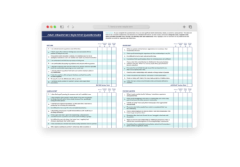What Happens When You Experience Trauma and Stress
Imagine you’re walking down a quiet street when, suddenly, a loud bang sounds behind you. Before you consciously register the noise, your body springs into action. Your muscles tense, your pupils dilate, your heart races, and your senses sharpen. This lightning-fast reaction isn’t random—it’s a carefully orchestrated series of physiological changes designed to keep you safe.
Your body is an extraordinary machine, with a highly sensitive alert system that activates instantly. This rapid defense mechanism, known as the threat response sequence, is an adaptation that helps protect us in moments of danger.
Rooted in our nervous system and developed over millennia, the threat response sequence prepares us to handle potential threats—whether from physical danger or psychological stressors.
Unfortunately, traumatic experiences or chronic stressors can disrupt our natural threat sequence, and create unresolved or “incomplete” responses. Over time, this shifts our threat detection and response systems toward hypervigilance and potential re-traumatization.
We can become stuck in the fight, flight, freeze, or fawn modes––mechanisms meant to protect us—that instead lead to emotional regulation challenges, mental health issues, and even physical problems.
The Threat Response Sequence infographic below provides a visual guide to this important process—detailing the stages of the threat response sequence, and some of the symptoms that may accompany incomplete or “stuck” responses.
With this knowledge, you can work more effectively with your body to process and release trapped energy, build greater resilience, and respond more effectively to future stimuli.
Download our infographic below and learn to harness the power of your natural threat response!
Learn how your body responds to trauma and stress…
Download or print this infographic to understand your body’s threat response sequence and restore balance while building resilience.

Share this Article:
Top Picks for You:
- The Four Attachment Styles: Secure, Avoidant, Ambivalent, and Disorganized
- Toxic Shame: What Is It & What to Do About It
- The Power of Trauma-Informed Care: Understanding What Happened to You
- Somatic Resilience: Overcoming Early Trauma (with Peter A. Levine, PhD)
- Neuroplasticity: Rewiring the Traumatized Brain





Ready to Begin Your Healing Journey?
Browse on-demand courses and begin learning from top experts today!


